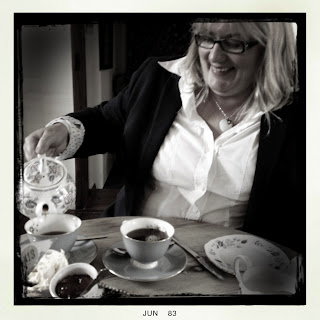 |
| A Proper Tea is much nicer than a Very Nearly Tea, which is one you forget about afterwards. A. A. Milne - Winnie the Pooh |
Ashdown Park Hotel, Wych Cross, East Sussex - Saturday 29th June 2013
_____________________
Tea Takers
Sarah Ryan
Paul Ryan
Olivia Ryan
Pat Ryan
Marion Ryan
Marie Ryan
Kathleen Sands
_____________________
A Ryan family tea, this time - with Paul's parents, sister and aunt - not only as part of my ongoing fortieth but also to celebrate the birthdays, just this last week, of Marie and Paul. All excellent excuses to indulge in another rather lovely country house hotel visit.
____________________
Ashdown Park and the Notre Dame connection
We had spied the hotel on a day out on the Ashdown Forest some time ago, and it looked a very likely tea venue; it certainly did not disappoint.
In 1919 it was purchased by the Order of the Sisters of Notre Dame of Namur, to be training house for novices. The Sisters built two large wings and a church, and ran a convent here until 1971. As I was educated at a Notre Dame school, this seemed a wonderfully serendipitous link (and has made me feel emotionally proprietorial about the place), and whilst the chapel has been deconsecrated and subsequently converted into function rooms, the legacy of the order's life here remains in lots of small (and not so small) details.
After subsequent incarnations as an American international university and a large bank's training centre, it has been a hotel for some twenty years and is a beautiful setting with its manicured gardens, a lake, woodlands and grazing land roamed by wild deer.
_____________________
We took tea in an elegant and comfortable room, with very English understated stately home charm. Service was attentive and prompt, but unobtrusive, and it was a most relaxing setting and situation.
The scones were delicious; fresh and light, and were accompanied by plentiful clotted cream and a choice of jams and honey. Sandwiches achieved much approval. The cakes were beautifully presented and little chocolate pots filled with raspberry mousse and topped with mint jelly were a pleasantly unusual sweet.
I think we may not need to eat again for some time.
It was, then, both necessary and desirable to wander the grounds after tea, and to make the most of the surprisingly seasonal sunshine.
____________________
Fourteenth Tea - Fourteenth Year
____________________
The Ashdown Forest and the Enchanted Places
The Ashdown Forest is an area of open heathland, on the sandy northern ridge of the High Weald, with beautiful views across the wooded hills of the Weald itself, to both the North and the South Downs. Despite its name it is only about forty percent wooded, and this is likely never to have been higher. From Norman times the area was hunting forest, and this term applies not to a landscape covered with trees but to a royal hunting ground with special powers to protect the deer within it. Henry VIII still had a hunting lodge here and from this courted Anne Boleyn at the nearby Hever Castle. The many place names with 'Hatch' and 'Gate' recall the ancient entrances to the forest's 'pale' or fence.
Originally much larger, in 1693 more than half of the forest was taken into private hands, but the remaining common land of just under ten square miles, is still the largest area with open public access in South-East England.
We often drive across the forest and are gradually exploring more of it on foot.
A.A. Milne lived on the northern edge of the forest and it was here that he set the stories of Winnie-the-Pooh et al. Numerous locations are easily identifiable, and still recognisable from E.H. Shepherd's illustrations. On our way to tea today, we stopped off at Gills Lap - named Galleons Lap in the stories - where one of the 'clumps' of pines, planted on forest summits from the 1820s, affords expansive views.
They walked on, thinking of This and That, and by-and-by they came to an enchanted place on the very top of the Forest called Galleons Lap, which is sixty-something trees in a circle; and Christopher Robin knew that it was enchanted because nobody had ever been able to count whether it was sixty-three or sixty-four, not even when he tied a piece of string around each tree after he had counted it. Being enchanted, its floor was not like the floor of the Forest, gorse and bracken and heather, but close-set grass, quiet and smooth and green. It was the only place in the Forest where you could sit down carelessly, without getting up almost at once and looking for somewhere else. Sitting there they could see the whole world spread out until it reached the sky, and whatever there was all the world over was with them in Galleons Lap.
From The House at Pooh Corner
Tigger and Eeyore, or should that be Piglet and a Heffalump, approach Galleons Lap.
_____________________































































